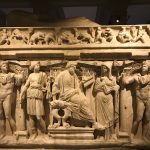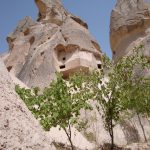There’s hardly a small town in Turkey that doesn’t have its own museum and most of them follow a standard plan with one section devoted to archaeology and another to ethnography while a collection of miscellaneous bits and pieces are dotted about the grounds. Unfortunately many of the museums are tucked away in places where few visitors are likely to find them, while very few have adequate labelling in Turkish let alone in any other language.
Leading the way to a brighter future are a handful of privately owned and run museums in İstanbul and elsewhere, but there are also some state-run museums which, while not quite up to the standards of their triple-A-starred counterparts, are still worth going out of your way to find. The coming of the Müzekart (Museum Card) suggested a new enthusiasm for getting visitors through the doors and some of the smallest museums no longer bother putting people off with an entry fee.
Sakıp Sabancı Museum, İstanbul
Looking out over the Bosphorus from a beautifully landscaped hillside at Emirgan and with a prominent statue of a white horse on the lawn, the Sakıp Sabancı Museum is worth visiting as much for its location as for its contents, which include a fine collection of Turkish calligraphy, and many 19th and 20th-century paintings, including works by the Italian-born court painter Fausto Zonaro, and the Turkish Orientalist artist Osman Hamdi Bey. The grounds contain an assortment of marble fountains and other masonry, some of it dating back to Roman and Byzantine times. Three of the ground-floor rooms retain the 18th and 19th-century furnishings that were in use when this was a Sabancı family home.
Open: Closed Mondays. Open 10am-6pm Tuesday to Sunday. Admission: TL170 (free on Tuesdays)
Sadberk Hanım Museum, İstanbul
If you can’t get to Ankara’s Museum of Anatolian Civilisations you might want to stop by this cut-down version housed in a pair of wooden houses overlooking the Bosphorus at Büyükdere. The older of the two buildings contains collections related to the history of Turkish and Islamic art, while the second houses archaeological collections arranged in chronological order. In particular look out for fine examples of the sort of Beykoz glass which used to be produced on the opposite side of the Bosphorus. Three rooms have been set up to show off traditional circumcision and coffee-making ceremonies as well as what a lying-in room would have looked like in Ottoman times.
Open: 10am-5pm. Closed Wednesdays. Admission: TL250 (TL120 Turks)
Why would you want to go out of your way to visit Uşak? Well, because it is home to the fabulous Kanun Treasure (also known as the treasure of Croesus), a superb collection of Lydian silver that finally wound up here in 1993 after a prolonged illegal sojourn in New York’s Metropolitan Museum of Art. The silver comes from the ancient burial mounds which covered the remains of the 6th-century BC Lydian kings, and includes some elegant bowls, a jug with the tiny figure of a naked acrobat forming a handle and some very Egyptian-looking jewellery. Just as wonderful are the remains of wall paintings depicting a young woman in a long scarf and red robe, and a young man and woman facing each other, their long almond-shaped eyes harking back to Egyptian prototypes.
In 2006 an outcry greeted the discovery that a fake had been substituted for a particularly lovely brooch in the shape of a winged seahorse. The museum director was one of a group of people convicted of stealing from the museum, a tragedy that might have been averted if more people visited it. The collections have since been moved into a fine new building.
Closed Mondays. Open:9am-5pm. Admission: 3 euros
Bursa City Museum
Bursa City Museum, housed in an old courthouse in the city centre, displays mannequins of the Ottoman sultans with a headphone commentary explaining their role in Turkish history. The basement has intriguing reconstructions of old shops together with some grainy film showing felt-makers hard at work pounding wool with their chests in the humidity of the old hamams. The gift shop and small café were amongst the first in the country to show a way in which museums might be made self-supporting.
Open: 9.30am-6pm Monday to Friday, 10am-6.30pm Saturday and Sunday.
Bergama Museum
Bergama’s is in many ways a typical provincial museum except that its location, in a hugely important historic town, ensures that its exhibits are more than usually impressive. In particular there are several statues from a local school of sculpture that was heavily influenced by that of Afrodisias; the finest of all is a figure of Aphrodite that was dredged from mud at nearby Allianoi, a spa resort dating back to antiquity that was drowned by the Yortanlı Dam. Hopefully you will also be able to see the ethnography section which houses a particularly rich collection of costumes and textiles but is only sporadically open.
Open daily 8.30am-8pm. Admission: 3 euros
Pamukkale Museum
Housed inside the old Roman baths of Hierapolis above the famous snow-white travertines, the Pamukkale Museum is a small gem that comes in three parts. The first displays some of the huge and finely carved sarcophagi retrieved from the sprawling necropolis while the other two showcase small finds from Hierapolis as well as some of the lovely statues produced in nearby Afrodisias.
Open daily: 8am-8pm. Admission with rest of site: 30 euros
Suna and İnan Kiraç Kaleiçi Museum, Antalya
Hidden away in the heart of Kaleiçi, the old walled part of Antalya, this small private museum is partly housed inside a restored 19th-century church and partly inside a restored Ottoman house. The church offers a light-filled home to a collection of ceramics from Kütahya and Çanakkale, while the house shows off fairly predictable dioramas of the major events in Turkish lives: marriages, circumcisions and drinking coffee! The lovely black and white pebbled courtyards alone almost justify a visit.
Open daily 9am-5pm. Admission: TL30
Mardin Museum
Way out in the south-east of Turkey, Mardin Museum is housed in one of the gorgeous honey-coloured houses for which the town is renowned. It’s the building itself that is the real treasure here. However, some of the exhibits inside explain aspects of local culture that differ from elsewhere in Turkey, in particular the ceremony attached to the making and drinking of bitter mirra coffee.
Closed Mondays. Open: 8am-5.30pm. Admission: TL90
İzmir Ethnography Museum
Housed inside a stately 19th-century building that was once İzmir‘s St Roche Hospital, this wonderful museum does its best to remind visitors of Turkey’s dying handicrafts, including felt-making, tinning, embroidery and manufacturing blue and white “evil eye” amulets. Another display also explains camel wrestling, a particularly Turkish sport that takes place along the Aegean coast in winter. With time on your hands you can also pop across to the Archaeology Museum, which is housed nearby in a completely separate building.
Open daily: 8a.30m-5.39pm. Admission: free
Museum of Health, Edirne
Out in the water meadows that ring Edirne stands the II. Beyazıt mosque complex, which is worth visiting not just in its own right but also for the chance to explore the Museum of Health that has been created inside the darüşşifa, the original medical centre attached to the mosque. Just to prove that there’s nothing new under the sun, you’ll find out here that such seemingly new-fangled aspects of alternative medicine as music and aromatherapy actually have a history stretching all the way back to early Ottoman times.
Open daily: 9am-6pm. Admission: TL50 (TL20 Turks)

